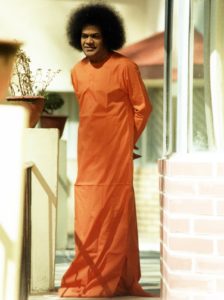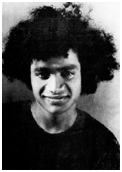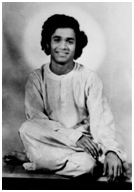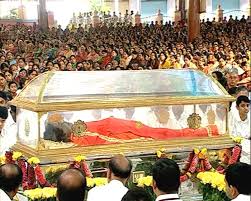
“I am God. And you too are God. The only difference between you and Me is that while I am aware of it, you are completely unaware.”
Sri Sathya Sai Baba was born as Sathyanarayana Raju on November 23, 1926 in the village of Puttaparthi, in the state of Andhra Pradesh in South India. Even as a child, His spiritual inclination and contemplative nature set Him apart from other children of His age, and He was known as ‘Guru’ and “Brahmajnani’ (knower of Brahman or Godhead) among His peers and others in the village. However, it was not until October 20, 1940, the day He made the historic declaration of His Avatarhood, (Avatar – Divinity Incarnate) that the world at large learnt of this divine phenomenon.
Revealing the purpose of His Advent, In Sai Baba own words,
“This Sai has come in order to achieve the supreme task of uniting the entire mankind as one family through the bond of brotherhood, of affirming and illuminating the Atmic Reality (Atma – The Self) of each being, to reveal the Divine which is the basis on which the entire cosmos rests, and of instructing all to recognise the common Divine Heritage that binds man to man, so that man can rid himself of the animal and rise up to the Divine, which is the goal.”
Sri Sathya Sai Baba is a great spiritual Master, famed for His simple and sweet exposition of the greatest and most intricate of spiritual truths which form the fundamental teachings of all the religions of the world. Elucidating on His mission, Sai Baba declares
“I have come not to disturb or destroy any faith, but to confirm each in his own faith, so that the Christian becomes a better Christian, the Muslim a better Muslim and the Hindu a better Hindu.”
His formula for man to lead a meaningful life is the five-fold path of:
- Sathya (Truth)
- Dharma (Righteousness)
- Shanthi (Peace)
- Prema (Love)
- Ahimsa (Non-Violence)
- Love for God, fear of sin and morality in society – these are His prescriptions for our ailing world.
He is an inexhaustible reservoir of pure love. His numerous service projects, be it free hospitals, free schools and colleges, free drinking water supply or free housing projects, all stand testimony to His selfless love and compassion for the needy and less privileged. True to His declaration – “My Life is My Message”, He has inspired and continues to inspire millions of His devotees worldwide by His personal example to live the ideal that service to man is service to God. The Sri Sathya Sai Organization today has a presence in over 167 countries in the world and members undertake group service activities that benefit their immediate community.
His message of “Brotherhood of Man and the Fatherhood of God” is a spiritual salve that will lead mankind from the darkness of ignorance to the light of immortality. Indeed, very rarely does such a divine power walk the earth. As one devotee said, “Bhagawan Baba is nothing but Love walking on two feet”.

Life history :
Pedda Venkama Raju (Father of Sathya Saiji), was married to Easwaramma. Pedda Venkama Raju and Easwaramma were blessed with a son and two daughters in that order, Seshama Raju, Venkamma, and Parvathamma.
Some years passed and Easwaramma longed for another son. She prayed to the village gods, performed Sathyanarayana Puja and observed a number of rigorous vows. One day, an extraordinary incident occurred that heralded the descent of the divine into her womb.

The Divine Child
A very significant event occurred soon after the birth of the child, which revealed the divinity of the baby. One day, it was noticed that the bed of clothes on which the baby was lying was being moved up and down in a peculiar way by something underneath. They watched with bated breath and when they looked under the bed they found a cobra underneath! The snake was playing the role of Sesha to the Seshasai!
The baby was named Sathyanarayana because there seemed to be a significant relationship between the worship to that God and the realisation of the mother’s cherished desire.

The little “Brahmajnani”
The villagers soon started referring to little Sathya as “Brahmajnani”, the knower and proponent of Brahman or Godhood. Even at a young age, Sathya was known for His extraordinary love and compassion towards creation and aversion towards harming any creature. His heart melted at human suffering. Whenever a beggar appeared at the door and raised his cry, Sathya abandoned His play and rushed in, to force His sisters to dole out grain or food. The elders in the house tried to dissuade Him saying, “Look here! You may give him food; but, mind you, you will have to starve.”
While others in the family relished non-vegetarian food, little Sathya would advise them to desist from such cruel habits. Whenever such food was cooked in the household, the boy used to run to the Karnam’s (village chief) house, and partake of the food offered by Subbamma, the aged lady residing there, for they were Brahmins and vegetarians.
So distinct was His behaviour that a wag once nicknamed Him “the Brahmin child“!

The early school days
At the age of eight, Sathya was declared fit to proceed to the Higher Elementary School at Bukkapatnam, about two and a half miles from Puttaparthi. He had to start early, after a meal of cold rice and curds or cooked ragi (maize), rice and chutney, carry the afternoon meal in a bag, and with His companions make the arduous trek daily to Bukkapatnam.
The Pandhari Bhajan group
When He was about ten years of age, Sathya formed a ‘Pandhari Bhajan‘ group in the village of Puttaparthi. The group consisted of about sixteen to eighteen boys dressed uniformly in ochre clothes, holding each a flag in the hand and wearing jingling anklets. They all danced to the tune of folk-songs and ballads, describing the yearning of pilgrims for Lord Panduranga’s Darshan. He also added some Bhagavatha songs of His own.
At Kamalapuram
Sathya had to move to Kamalapuram, a small town about 200 kilometres from Puttaparthi, with His brother Seshama Raju. His parents planned to give Sathya a college education, so that He may become an officer! And hence, they were prepared to part with their beloved son and send Him to Kamalapuram to the Board Middle School there, so that His studies could be continued.
Meanwhile, Seshama Raju was transferred to Uravakonda. He decided to take Sathya along with him with the intention of admitting Him at the Sri Karibasavaswami District Board High School there. Accordingly, Sathya accompanied His elder brother to continue His studies at Uravakonda.

Mysterious Turn of events at Uravakonda
On March 8, 1940, the whole town was shocked to hear that a big black scorpion had stung Sathya in the twilight hours of the evening. However, Sathya slept that night without any sign of pain! Every one felt relieved, only to become anxious once again when the next evening, Sathya fell unconscious and became stiff; He would not speak and breathing appeared faint. Seshama Raju brought in a doctor, who gave an injection and left behind a mixture. Sathya was apparently unconscious throughout the night. The doctor came again in the morning and declared that the boy was out of danger!
An incident happened in the night which showed that Sathya was not ‘unconscious’ but, that He was actually supraconscious!

Some one suggested that the local deity be propitiated, because the condition of the boy may be due to some evil spirit that possessed Him. So, volunteers hurried to the temple and offered worship, placed flowers and incense, and broke a coconut at the altar. At that very moment, Sathya, who was to all intents ‘unconscious’, said, “The coconut has broken into three pieces,” and when the volunteers came home with the offerings, they had with them three pieces and not the usual two!
Sathya got up in a day or two and began to behave in an extraordinary way. He has said that He Himself initiated the process of manifestation, for He could not wait any longer, playing about as a mere boy, with ‘brother’ and ‘sister’ and ‘classmates’ and other secular bonds. He was beyond both ‘Visha’ and ‘Vishaya’, that neither the poison of the scorpion nor worldly attractions could ever affect Him.
Divine Fortitude
The parents were beside themselves with worry at the condition of Sathya; He sang and spoke and behaved in such a queer manner. It was all so mysterious. At that time, someone gave information to the worried parents that there was an expert exorcist before whom no evil spirit dare wag its poison tail! He will cure Sathya perfectly and make Him fit to go to school, they assured.

The exorcist was a gigantic figure, terrible to behold, with blood-red eyes and untamed manners. He tried all his craft which he dared not experiment even with strong adult patients! For example, he shaved the head of the boy and, with a sharp instrument scored three ‘X’ marks on the scalp, from the top towards the forehead. Sathya sat through the pain without wilting. With the scalp injured and bleeding with those markings, the witch doctor poured on the open wound the juice of lime, garlic, and other acidic fruits.
The parents who were watching the proceedings in utter despair were surprised, for there was not even a tear, or a gasp of pain from the boy! But the exorcist was unrelenting and put the boy through even more terrifying trials until the parents could bear to see it no more. They wanted to save the boy from the jaws of that Yama (God of Death) in human form; they had seen and suffered enough. They paid him full fees and also gave some unasked gifts, and thanked him for all the ‘learning’ he had utilised.
The Mission Begins
On the 20th day of October, 1940, the day after they all returned from Hampi, Sathyanarayana started for school as usual. However, within a few minutes, He returned to the house. Standing on the outer doorstep, He cast aside the books He was carrying and called out, “I am no longer your Sathya. I am Sai”. The sister-in-law came from the kitchen, only to be blinded by the splendour of the halo around Baba’s head! He addressed her, “I am going; I don’t belong to you; Maya (delusion) has gone; My Bhaktas (devotees) are calling Me; I have My Work; I can’t stay here any longer.”

When the brother hurried home on hearing all this, Baba only told him, “Give up all your efforts to ‘cure’ Me. I am Sai; I do not consider Myself related to you”.
In spite of repeated pleas, Sathya would not step into that building again. He moved in into the garden of the Excise Inspector Sri Anjaneyulu’s bungalow, and sat on a rock in the midst of the trees. People came into the garden from all directions bringing flowers, fruits, incense and camphor to worship Him. The garden resonated with the voices of hundreds singing bhajans (devotional singing) and following the lines of the first prayer that Sri Sathya Sai taught them.
“Manasa Bhajare Gurucharanam Dusthara Bhava Sagara Tharanam “
(O Mind! Meditate on the Feet of the Guru, which will take you across the wearisome sea of Samsara or worldly existence.)

A few days later, Sathya Baba left Uravakonda for Puttaparthi. There, He shifted to the house of Karnam whose aged and devout wife Subbamma attended on Him with love and affection and welcomed all devotees into her spacious house; she spared no effort to make their stay happy and comfortable. Baba often speaks about her dedicated service, working incessantly from dawn to dusk, cooking and making other arrangements for the hordes of devotees who began to land in Puttaparthi every day.
As the number of devotees swelled, a mandir (temple) was constructed in February 1947, where He began to reside and grant darshan. On 23rd November 1950, Prasanthi Nilayam was inaugurated, which remains till today the central venue for Bhagawan’s darshan and the festival celebrations that take place in His Divine Presence.
He said:
I have a Task: To foster all mankind and ensure for all of them lives full of Ananda (Bliss).
I have a Vow: To lead all who stray away from the straight path, again into goodness and save them.
I am attached to a Work that I love: To remove the sufferings of the poor and grant them what they lack.
I have a reason to be proud, for I rescue all who worship and adore Me.

Sathya Sai Organization
The Sathya Sai Seva Organization is a non-denominational organisation that was founded in the 1960s
“The main objective of the Sathya Sai Organization,” as Sathya Sai Baba states, “is to help man recognize the divinity that is inherent in him. So, your duty is to emphasize the One, to experience the One in all you do or speak. Do not give any importance to differences of religion or sect or status or color. Have the feeling of one-ness permeate every act of yours. Only those who do so have a place in this Organization; the rest can withdraw.”
The Sathya Sai Organization, to enable its members to undertake service activities as a means to spiritual advancement”, has over 1,200 Sathya Sai Centres (branches) in 126 countries. Through this organisation, Sai Baba established a network of free hospitals, clinics, drinking water projects, auditoriums, ashrams and schools

Educational institutions
Sai Baba’s educational institutions aim to impart character education along with excellence in academics with emphasis on human values and ethics.
Sri Sathya Sai Institute of Higher Learning
Sri Sathya Sai Institute of Higher Learning (Deemed to be University), established in 1981, called Sri Sathya Sai University for some years, of which Sai Baba was the Chancellor, has four campuses, one at Puttaparthi for men, one at Whitefield, Banglore for men, one at Anantpur for women, and one at Muddenahalli for men.
Sri Sathya Sai Higher Secondary School
The Sri Sathya Sai Higher Secondary School was founded by Bhagawan Sri Sathya Sai Baba on 15 June 1981 in ‘Sri Sathya Sai Vidya Giri’ complex of Prasanthi Nilayam, Puttaparthi. This is a boarding school with separate hostel for boys and girls. The school caters to classes I to XII of the Central Board of Secondary Education, , New Delhi [CBSE]. For 2014, it was ranked in the top 10 CBSE schools of India.

Hospitals and medical care
The Sri Sathya Sai Central Trust runs several general hospitals, two speciality hospitals, eye hospitals and mobile dispensaries and conducts medical camps in rural and slum areas in India.
Sri Sathya Sai General Hospital, Whitefield
The Sri Sathya Sai General Hospital, Whitefield was opened in Whitefield, Bangalore, in 1977 and provides complex surgery, food and medicines free of cost. The hospital has treated over 2 million patients.
Sri Sathya Sai Institute of Higher Medical Sciences, Puttaparthi
The Sri Sathya Sai Institute of Higher Medical Sciences, Puttaparthi is a 300-bed facility which provides free surgical and medical care and which was inaugurated by Prime Minister Narasimha Rao on 22 November 1991. The hospital was financed and its construction supervised by Isaac Tigrett, founder of the Hard Rock Cafe and House of Blues.
The hospital is equipped 11 surgical theatres, five intensive care units, two cardiac catheterisation laboratories, medical and surgical wards, and a 24-hour emergency unit. “Leading doctors specialising in the fields of Cardiology, Cardio Thoracic and Vascular Surgery, Urology, Ophthalmology etc. come from different parts of the World on their own and render their services free of cost.”
The hospital has a unique history of its own. On 23 November 1990, during his birthday discourse, Sri Sathya Sai Baba while talking about the inability of healthcare access to the poor declared within one year a tertiary care hospital will come up in the village of Puttaparthi, which will provide high-end care completely free to all the patients. The hospital was constructed in a record time of exactly one year and the first cardiothoracic operations were carried out successfully.
Sri Sathya Sai Institute of Higher Medical Sciences, Whitefield
Sri Sathya Sai Super Speciality Hospital, Whitefield (suburb of Bangalore), Karnataka, India
After the success of the first super speciality hospital, the Karnataka government offered Sai Baba 53 acres of land to establish another super speciality hospital in Whitefield.
The Sri Sathya Sai Institute of Higher Medical Sciences, Whitefield is a 333-bed hospital, which was inaugurated on 19 January 2001 by Prime Minister Atal Behari Vajpayee. The estimated cost of this second hospital was Rs 2000 million. The hospital has provided free medical care to over 250,000 patients.
Temple :
In 1968, he established Dharmakshetra or the Sathyam Mandir in Mumbai. In 1973, he established the Shivam Mandir in Hyderabad. On 19 January 1981, in Chhennai, he inaugurated the Sundaram Mandir.
Other Projects:
In March 1995, Sai Baba started a project to provide drinking water to 1.2 million people in the drought-prone Rayalaseema region in the Anantpur district of Andhra Pradesh. In April 1999 he inaugurated the Ananda Nilayam Mandir in Madurai, Tamil Nadu.
In 2001 he established another free super-speciality hospital in Banglore to benefit the poor. The Vancouver Sun in 2001 reported that Sai Baba told his adherents not to browse the Internet after Sai Baba said, “These teachings (the Vedas) are highly sacred. Today people are ready to believe all that they see on television and internet but do not repose their faith in the Vedic declarations. Internet is like a waste paper basket. Follow the ‘innernet,’ not the internet.”

Old age and illness
In 2003, Sai Baba suffered a fractured hip when a student standing on an iron stool slipped and the boy and stool both fell on him. After that he gave darshana from a car or his porte chair. After 2004, Sai Baba used a wheelchair and began to make fewer public appearances.
On 28 March 2011, Sai Baba was admitted to the Sri Sathya Sai Super Speciallity Hospital at Prashantigram at Puttaparthi, following respiration-related problems. After nearly a month of hospitalisation, during which his condition progressively deteriorated, Sai Baba left the body on Sunday, 24 April at 7:40 IST, aged 84.
His body lay in state for two days and was buried with full state honours on 27 April 2011. An estimated 500,000 people attended the burial, among them the Indian Prime Minister Manmohan Singh , Congress president Sonia Gandhi, then Gujarat Chief Minister Narendra Modi, Cricketer Sachin Tendulkar and Union Ministers S.M. Krishna and Ambika Soni, as well as other political leaders and prominent figures.
Controversies:
There is a powerful gang of evil-minded persons behind ensnaring Saint ; but the ill resolves can be subdued by the stronger good resolves with determination that this resolve must work sooner or later without harboring any doubt. Jealousy was the motive behind the allegations leveled.
The alleged “exposure” of Hindu saints which has been targeted by the media covering a wide variety of charges ranging from rape to land grabbing to looting and the list seems to be endless. Other interesting point to note is that it is not one or two but many Hindu saints have been targeted during the years with intent to malign their public image. Repeated Broadcast of this kind of NEWS clearly shows that there is a gruesome plan in place targeted for a specific segment of the society.
Sai Baba publicly responded to the allegations on 25 Dec 2000 :
Some people out of their mean-mindedness are trying to tarnish the image of Sai Baba. I am not after name and fame. So, I do not lose anything by their false allegations. My glory will go on increasing day by day. It will never diminish even a bit if they were to publicise their false allegations in the whole world in bold letters. Some devotees seem to be perturbed over these false statements. They are not true devotees at all. Having known the mighty power of Sai, why should they be afraid of the ‘cawing of crows’? One should not get carried away by all that is written on walls, said in political meetings or the vulgar tales carried by the print media.



